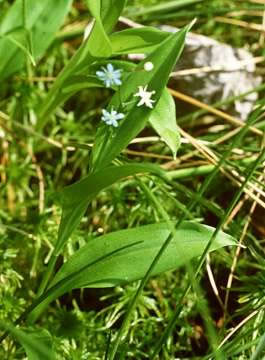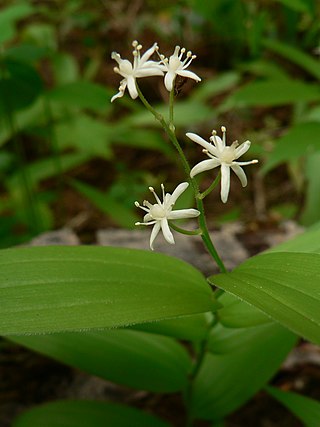
Clintonia is a genus of flowering plants in the lily family Liliaceae. Plants of the genus are distributed across the temperate regions of North America and eastern Asia, in the mesic understory of deciduous or coniferous forests. The genus, first described by Constantine Samuel Rafinesque in 1818, was named for DeWitt Clinton (1769–1828), a naturalist and politician from the U.S. state of New York. For this reason, plants of the genus are commonly known as Clinton's lily. The common name bluebead refer to the distinctive fruit of members of the genus. Since fruit color varies somewhat across species, the common name bead lily is used as well.

Maianthemum includes the former genus Smilacina and is a genus of perennial herbaceous flowering plants with fleshy, persistent rhizomes. It is widespread across much of North America, Europe and Asia, and may be terrestrial, aquatic or epiphytic. It is characterized by simple, unbranched stems that are upright, leaning or hanging down and have 2–17 foliage leaves. Leaves are simple and may clasp the stem or be short-petiolate. The inflorescence is terminal and either a panicle or a raceme with few to many pedicelate flowers. Most species have 6 tepals and 6 stamens; a few have parts in 4s. Tepals are distinct in most species and all of similar size. Flowers are spreading, cup-shaped or bell-shaped and usually white, but lavender to red or green in some species. Fruits are rounded to lobed berries containing few to several seeds.

Maianthemum dilatatum is a common rhizomatous perennial flowering plant that is native to western North America from northern California to the Aleutian islands, and Asia across the Kamchatka Peninsula, Japan, and Korea. It grows in coastal temperate rainforests, and is often the dominant groundcover plant in Sitka Spruce forests.

Maianthemum racemosum, the treacleberry, feathery false lily of the valley, false Solomon's seal, Solomon's plume or false spikenard, is a species of flowering plant native to North America. It is a common, widespread plant with numerous common names and synonyms, known from every US state except Hawaii, and from every Canadian province and territory, as well as from Mexico.

Maianthemum trifolium is a species of flowering plant that is associated with extremely wet environments and is native to Canada and the northeastern United States as well as St. Pierre and Miquelon and Asia (Siberia).

Maianthemum bifolium is often a localized common rhizomatous flowering plant, native from western Europe east to Siberia, China and Japan.

Maianthemum stellatum is a species of flowering plant, native across North America. It has been found in northern Mexico, every Canadian province and territory except Nunavut, and every US state except Hawaii and the states of the Southeast. It has little white buds in the spring, followed by delicate starry flowers, then green-and-black striped berries, and finally deep red berries in the fall.

Prosartes hookeri is a North American species of flowering plants in the lily family known by the common names drops of gold and Hooker's fairy bells.

Rubus pubescens is a herbaceous perennial widespread across much of Canada and the northern United States, from Alaska to Newfoundland, south as far as Oregon, Colorado, and West Virginia.

Oxalis montana is a species of flowering plant in the family Oxalidaceae known by the common names mountain woodsorrel, wood shamrock, sours and white woodsorrel. It may also be called common woodsorrel, though this name also applies to its close relative, Oxalis acetosella.

Smilax laurifolia is a species of flowering plant in the greenbrier family known by the common names laurel greenbrier, laurelleaf greenbrier, bamboo vine, and blaspheme vine. It is native to the southeastern United States, where it occurs along the Gulf and Atlantic coastal plains from Texas to New Jersey, the range extending inland to Arkansas, Oklahoma, and Tennessee. It also occurs in Cuba and the Bahamas.

Maianthemum paniculatum is a perennial flowering plant; a species of monocot found from Mexico to Panama. It is often associated with montane environments and is found primarily in forest openings and along roadsides.

Maianthemum gigas is a perennial flowering plant. It is found in Mexico and Central America, growing in forest openings and along roadsides or sometimes as an epiphyte on trees.
Maianthemum paludicola is a perennial flowering plant. It is a rare terrestrial herb, endemic to Costa Rica. It has only been found in high-elevation bogs and wetlands and was first described in 1986.
Maianthemum macrophyllum is a perennial flowering plant. It is a rare epiphtic herb endemic to Veracruz and Oaxaca, Mexico and is known only from primary cloud forests, usually growing on limbs of oaks or sweetgum.

Maianthemum scilloideum is a perennial flowering plant. It is a terrestrial forest herb from southern Mexico and Guatemala and also reported from Honduras.
Maianthemum flexuosum is a perennial, terrestrial understory herb of cloud forests from southern Mexico to Nicaragua. It has been found at sites from 1300 to 2800 m elevation.
Maianthemum salvinii is a rare perennial, epiphytic herb found in southern Mexico and Guatemala.
Maianthemum mexicanum is a perennial, terrestrial herb found as an understory species in moist forests. It is endemic to west-central Mexico.
Maianthemum comaltepecense is a rare perennial, terrestrial herb found as an understory species in moist forests and endemic to southwest Mexico.





















